An Expedition with No Drama
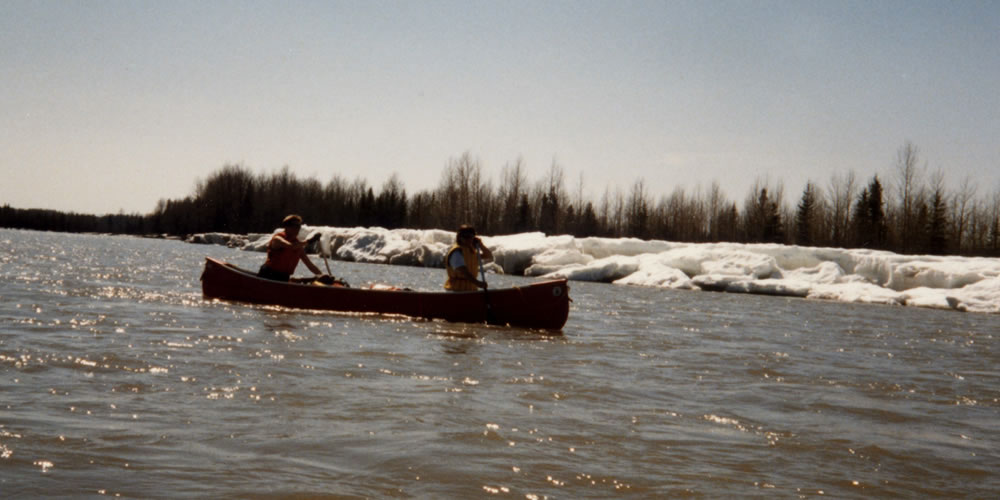
Thirty years ago as a student at the University of Alberta, I participated in a life-changing 90-day canoe expedition1. It is an excellent example of how to succeed in wilderness canoe tripping. Sadly with ninety days of canoeing, I have no drama or harrowing adventures to tell you about, because we did it right. This expedition was the highlight of two intensive years of study, in which I and my five fellow Outdoor Education students2 together planned and then conducted this canoe expedition.
“There is magic in the feel of a paddle and the movement of a canoe, a magic compounded of distance, adventure, solitude, and peace. The way of a canoe is the way of the wilderness, and of a freedom almost forgotten. It is an antidote to insecurity, the open door to waterways of ages past and a way of life with profound and abiding satisfactions. When a man is part of his canoe, he is part of all that canoes have ever known.” — Sigurd Olsen3
The expedition ran between April 29th and July 31st, 1989. Canoeing from Rocky Mountain House, Alberta, to Thunder Bay, Ontario. We crossed Alberta, Saskatchewan, Manitoba and north-western Ontario while skirting the northern Minnesota border or, as its more popularly known the “Border Waterways.” We canoed in tandem canoes with no shore support and little outside contact4. Even though we followed a well-known voyageur route, we did not recreate history; instead, we immersed ourselves in a way of life that of the expedition canoeist.
Dream — and Dream Big

So, why did we do it in the first place? Because we could. But mostly because our institution and our facilitators allowed us to dream — and dream big. One of the important lessons for all outdoor educators was that participants were asked as part of the “Explorations Program5” to dream up expeditions. The program's structure allowed us lots of time to plan.
This was part of the planning process that started a year before our actual “Explorations Term,” i.e. September 1988 to April 1989, in which we received university credits6. We started by meeting regularly and creating a mission statement. Not because we had to, but because we believed in the process and embraced it.
“Explorations 88-89 Mission Statement: As a self-directed group we strive to develop people, self and program skills; while reading, researching, and experiencing history, environmental education, adventure, personal growth, in the context of extended wilderness expeditions. As quality outdoor leaders we hope to share the magic of the outdoors with others.”
We went through an extensive planning process and brainstormed many trips we wanted to do. Then we whittled the list down to five trips, of which we finally chose to do only four. Explorations 88-89 chose to dream big. This brainstorming process was incredibly important, took a lot of time, hard work by ourselves, and help from our facilitators. This eventually led to us crossing the country by canoe without our hands being held by an institution or a staff member.

Many doubted we would succeed. Some early participants dropped out of the programme along the way. Many of us were warned and counselled by faculty members during the planning process, and even just before the departure date, that since the expedition was going to be a failure, we should not attempt it. “Cut it back, shorten it and make it realistic,” we were told again and again.
These disheartening memories still bother me and came up numerous times at our 30th-anniversary reunion, so I know I was not alone. This lesson in bad leadership and mentorship has been lodged in my mind and helps me to remember to help out equally those who I think will succeed and those who may not. You will never know who will really succeed in life until they do or don't.
In September of 1988, we returned to university and conducted a reasonable successful week-long canoe trip from Nordegg to Rocky Mountain House. We found ourselves that fall reduced from the original participants to the six who conducted the final expedition and our teaching instructor Donald Burry.
The trip we took that fall was not the one we had planned for at all. It started as planned but turned out to be two long days of total failure, involving a long portage up a mountain pass to the start of a river that did not have enough water in it to paddle. Followed the next day instead with a portage back down to the Icefields Parkway.
Instead of giving up and going back home, we drove back east and paddled down a section of the upper North Saskatchewan River. Since all of us had paddled this section once or twice by then, we felt it would be a good choice. We knew we had failed and we picked ourselves up and succeeded. This lesson in failure helped us out in both our contingency planning and on the expedition. It also should remind all of us that it is alright to fail on a wilderness trip.
Quite soon after our first canoe trip, Donald Burry bowed out of canoeing with us in the spring and we were left with six. This seemed to redouble some people's efforts to get us to give up. All the jocks were gone. Inside, we all felt like the underdog: five women and one guy, who was not a jock but a short-haired army reservist7.
“Twenty years from now you will be more disappointed by the things that you didn't do than by the ones you did do. So throw off the bowlines. Sail away from the safe harbour. Catch the trade winds in your sails. Explore. Dream. Discover.” — Unknown8
But like any dog worth its salt, we set our teeth into the task. So we got down to the business of planning, fund raising9 and packing for the trip. We did anything we could to raise money, even selling individual kilometres of the trip. The trip needed to be entirely self-funded. Sadly, none of our bigger funding requests10 came though. We even had to buy two of our canoes and borrow the third, after our university outdoor centre said we had to rent canoes at a daily rate.
Dr. Harvey Scott, Dr. Lou Lanier and Chris Edgelow our facilitators, supported and nurtured our dream. If they doubted us, they never said it and always lent a helping hand. These three individuals equipped us with the tools to use before we departed, and we used them a lot along the way.
That does not mean we never argued or disagreed, but it does mean we all worked very hard to get along. We worked hard to communicate well, listened to each other's concerns and made all major decisions using a consensus decision-making process. The group was always willing to make tough calls together along the route to ensure that we all arrived safely in Thunder Bay.
The Odyssey Begins
Despite a lot of silliness getting funding, equipment and an amazingly small overall budget, we carried out a 90-day canoe trip. Without a GPS, satellite phone or SARSAT beacon11, just a two-page route card, compasses and a lot of topographical maps. On the expedition, I spent some time each night studying the maps for the next day and we all learned to read the water, always carefully looking ahead and taking no stupid chances. Most of the time, we were essentially on our own.
“Having an adventure shows that someone is incompetent, that something has gone wrong. An adventure is interesting enough – in retrospect. Especially to the person who didn't have it.” —Vilhjálmur Stefansson12
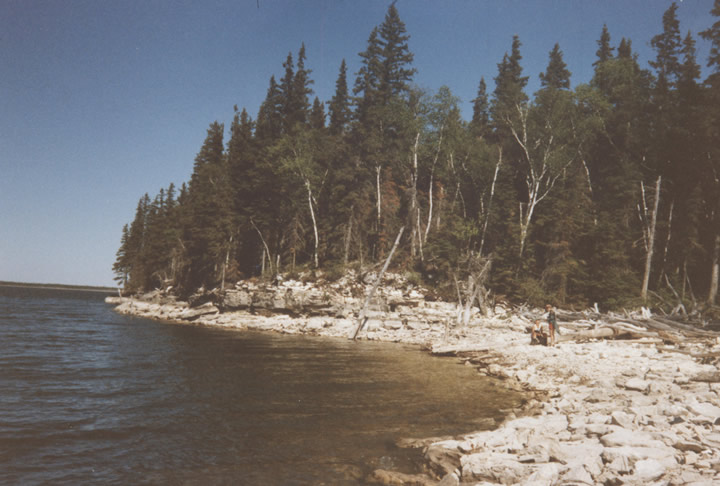
Ninety days of canoeing without drama, accidents or injuries. No adventures to tell the world about. None of us will ever write a book about it, no television or movie deals, because we did it right. Just beautiful scenery, 90-days of wonderful paddling and the memories of the great people we met on the journey. Even the one black bear we met just ambled northward up the beach past our canoes without more than a lazy glance at us as we paddled south.
We succeeded through hard work, perseverance, proper planning and learning as we went. Sadly that was not what people expected. Since we did succeed, the expedition was played down by many who assumed it must have been easy, since we had no real adventures on our expedition. We did have problems and difficulties; when they came up, we just worked our way through them as a group.
Explorations worked that year as it should have and gave us the experience to become real outdoor educators. The program did not work as well in other years, which reminds us that we do not always succeed in outdoor travel. It is also why the six of us worked so hard personally in our decision making and communication processes every single day of the trip.
“What sets a canoeing expedition apart is that it purifies you more rapidly and inescapably than any other travel. Travel a thousand miles by train and you are a brute; pedal five hundred on a bicycle and you remain basically a bourgeois; paddle a hundred in a canoe and you are already a child of nature.” — Pierre Elliott Trudeau 13
For me, the entire program was a life-changing experience. It taught me real outdoor skills and changed my entire idea of what a short or long trip in the wilderness is. Best of all, every one of the participants can still call themselves friends, 30 years on. The Explorations programme worked exactly as it should have and today I am an outdoor educator and bestselling author because that program worked; thank you, Harvey.
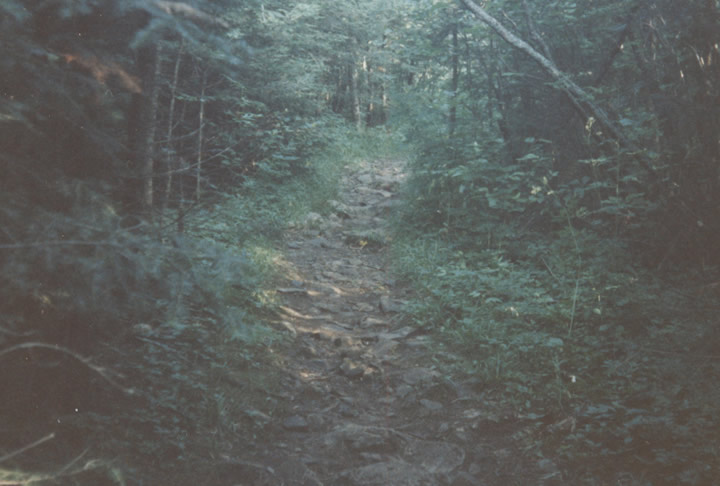
The expedition involved 3,000 km-plus of paddling, at least one quarter upstream, three sections of sailing, we lined our canoes through eleven areas, nine portages we dragged our canoes up the waterway or over a small height of land to avoid unloading our canoes and 40 portages, including the “Long Portage” and the gruelling 13.6 km “Grand Portage” which we were required, as all portages, to walk the route three times, two loaded with gear and once back to the start point. On these portages, most of us, especially the smaller individuals, regularly carried over 50% of their body weight.
“My canoe, it's a part of me, gliding over the water, going as fast as I want it to or my sore arms can make it. Except when I portage her, she embeds herself in my neck, seeming to burrow in, never to let go, like a tick she sucks my blood and is some days the catalyst for my tears.” — Carmen Ditzler14
The six of us canoed on average about 55 km per day on the Saskatchewan River system, although we always tried to achieve 60 km. It should not be a real surprise that, as we went along, we improved our efficiency and fitness. As we got to the bigger lakes in Manitoba, we also got hit by more days when we could not canoe at all. Along the way, we learned a real lesson that we needed to alter our schedule to accommodate nature, instead of keeping to a man-made schedule.
“Wilderness: a beautiful word to describe a beautiful land. Wilderness though is a white man’s concept. To the Native people, the land was not wild. It was home. It provided shelter, clothed and fed them. And echoing through their souls was a song of the land. The singing isn’t as loud as it used to be. But you can still hear it in the wind…in the silence of the misty morning…in the drip of the water from the tip of a paddle. The song is still here if you know how to listen.” — Bill Mason15
We attempted, but rarely achieved, our proposed 40 km per day paddling upstream on the Winnipeg and Rainy Rivers or in the Lake Country of the Border Waterways. This was mostly due to the portaging, dragging and lining required most days, and the packing and unpacking of the canoes. This process burnt up daylight hours and only so many efficiencies can be found.
The True Rigors of an Expedition
“The Way of the Canoe is the Way of the Wilderness and of a Freedom almost Forgotten.” — Sigurd Olsen16
We lived on a diet of dehydrated food that we had dried ourselves, prepared and packaged before we left, and basic staples like noodles, rice, flour, granola and margarine. We supplemented this with a limited amount of fresh food we were able to purchase along the route where possible and with whatever handouts we received. We cooked mostly over a fire and baked regularly using a Coleman oven over a bed of coals.
Our basic rations were approximately 3,000 to 3,500 Kcal per person per day, which at the beginning of the expedition was satisfactory. The food was divided up by days in a continually repeated menu with some days being slightly more calorie-rich than others. Our rations sizes were based on food taken on our two earlier weeklong trips. As the trip wore on, we found these rations less and less filling.
The last half of the expedition was the hardest and most intense part. In the last 20 days of the expedition, we were all continually hungry. We were burning a lot more calories than we were eating each day during this time. On a few occasions near the end of the expedition, we made a second supper by stealing rations from the last days of the trip. We supplemented our food with whatever we had in the Wannigan and by making bannock whenever we had time. As well, we also consumed as much beer, fresh fish and any snack food that we could find.
One of the effects of this much exertion, with insufficient food, was that, although we were all in excellent shape, still building upper body muscle, our bodies' fat supply was greatly reduced and everyone was having trouble sitting on the canoe seats all day, as most or all of the fat in our posteriors was gone. This caused problems: shortening days and lengthening stops as we now wanted to take more of our breaks on land, slowing us down.
By the end of the expedition, we were gaunt and extremely muscled, which along with our well-worn clothing made us look like a scruffy team of competitive bodybuilders. On the expedition, these changes were much harder to see, as you lived in the moment of getting up, canoeing, making supper and then getting some sleep. On a long expedition, your mode of travel becomes your occupation: in this expedition, we were no longer university students, instead, we were canoeing for a living as we headed for Lake Superior.
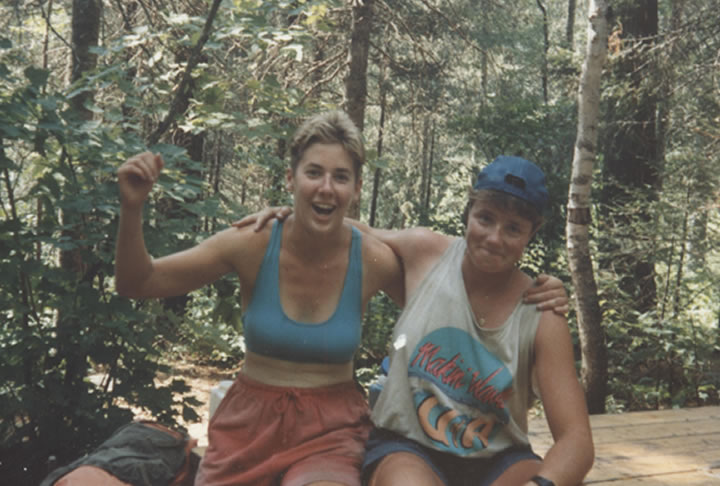
One of the other interesting side effects is that some members of the expedition gained a lot of weight after the expedition, even though they were active, as their bodies tried to store fats in case of another round of starvation. This quote highlights this best “…upon return from the trip, even though I was as active as normal, my body kept every calorie saved as fat because it must have been in starvation mode and not knowing when I would get normal amounts of food again. And as a result, I was the heaviest I have ever been, except for pregnancy later in life. It took about six months after the trip to get back to my normal weight.”17 I found that I ate ravenously for the first week or so after we finished Grand Portage and then my appetite reduced.
Ninety days of expedition canoeing ingrained in all of us the idea that we need to greatly increase the percentage of fats on longer expeditions, a minimum of 30% of your daily calories. This both saves weight and increases your daily calorie count. This can and should be taken to the extreme on winter expeditions by taking over 50% fats. This knowledge helped us out as we went on and when I advised serveral individuals going on long winter trips throughout the 1990s.
Ensure you take more food for tougher sections of any expedition by taking extra food to supplement your normal rations. If you are short of calories because you did not take enough food for a particular day, supplement your dinner that evening. Even today, I always take extra peanut butter, potato flakes, brown sugar and milk powder in my Wannigan. I know we needed those items on this expedition and used those extra rations a lot when things got tough, so now I always carry them, just in case.
On short trips, you can get away with a lot of things. You need to understand that you cannot cut corners on expedition food planning or ration your food on longer expeditions. You will simply wear yourself out or, as I like to say these days teaching survival, you will burn down your candle into a stub18. You need to feed the beast, and the tougher the route, the longer the activity and colder the temperatures, the more calories you will burn each day and the less fat you have to live off.
Some Snapshots from the Expedition
“…perhaps our grandsons, having never seen a wild river, will never miss the chance to set a canoe in singing waters…glad I shall never be young without wild country to be young in.” — Aldo Leopold19
There is no way to properly describe an entire 90-day canoe trip. It was a way of life, a job and an adventure without drama. In any outdoor expedition, there is more than the day-to-day activities, there's the life on the river: that indescribable magic that comes from successful wilderness travel together in a functioning group deep in the wilderness.

Each of us kept and made a logbook entry each day. Mine were all rather short, always dealing with weather and paddling conditions, much more than people and places. This made shrinking them down to Twitter size easier, but it was still a tough job. It's interesting after reading some excerpts from other logbooks and talking about the trip numerous times with everyone, how different we often saw small parts of the trip, yet how the major events and themes still came through in all our memories.
In celebration of the 30th anniversary, I wrote and posted 94 days of short excerpts from my logbook and included a picture with each post. I made these posts each day on Twitter, Instagram, LinkedIn and Facebook. I have included those 94 posts, plus a few extra comments and some of the best pictures that I have, to give you an idea of what it's like to dream big and what it takes to paddle across this great country successfully.
Canoeing the Vast Expanse — the Prairies
“If reaching the summit is only the final step of a long journey, then the people along the way may be as important as the peak, and an expedition to nowhere may become a modest journey to everywhere.” — Patty Sherman20
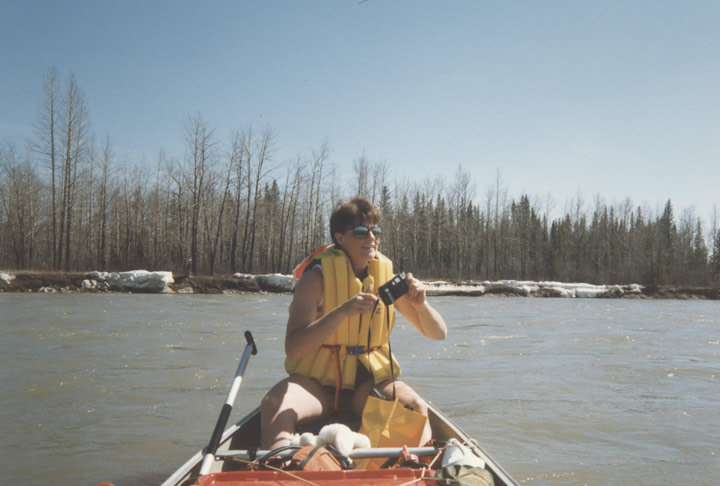
Explorations Day#1: 40 km on a very fast river, ice still prevalent on the river with some small floating chunks, hard to find good eddies to stop and a muddy campsite (Apr29/89).
Explorations Day#2: 40+ km on a slightly slower North Saskatchewan River, saw extensive ice along the banks and camped on a low river bank leaving our boats tied up on the side of the ice (Apr30/89).
Explorations Day#3: 40+ km on a much slower river with far less ice and camped on a very muddy area where we needed to make a stone and wood bridge to an actual dry shoreline (May1/89).
Explorations Day#4: 60 km of excellent paddling, Lunch at Genesee Bridge and camped on the island with slightly less mud than the last few days (May2/89).

Explorations Day#5: 40 km of very windy padding into Edmonton, stopped at Fort Edmonton and off the river by 14:30 (May3/89).
Explorations Day#6: Layover in Edmonton, pondered that day that the group had been much more together on this trip than on past trips and hoped that this first few days would last to Lake Superior (May4/89).
Explorations Day#7: Layover in Edmonton, did some shopping and went generally crazy as I tried to pack everything I would need for the next 85 days and did not take to Rocky with me (May5/89).
Explorations Day#8: 35 km on the North Saskatchewan River even though we left Fort Edmonton at Noon, some wind, but lots of pollution and a camp spot on the edge of a small field (May6/89).

Explorations Day#9: 56 km of good paddling, especially the last two hours, made camp just before the Waskatenau Bridge in a small forest (May7/89).
Explorations Day#10: 60 km of good padding, passing two Bridges and camping by 17:00. Really getting into the cycle of the trip, but got sunburned (May8/89).
Explorations Day#11: 53 km with strong winds, stopped for a late 1.5 hours Lunch at 14:00 and camped on a small island just past the Duvernay Ferry (May9/89).
Explorations Day#12: 57 km in high winds, grounded by wind and waves for much of the afternoon. Good paddling after 18:00 and need to paddle until 21:00 to finish the days paddling (May10/89).
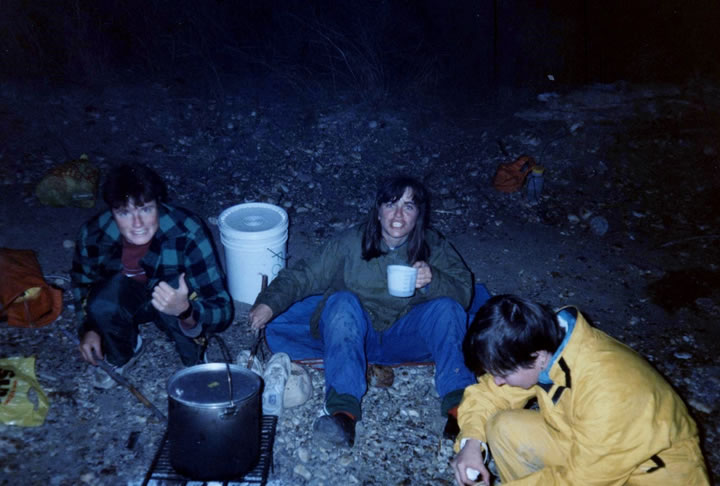
Explorations Day#13: 54 km with a lot of gusty high winds, heavy rain in the morning forcing us to paddle until 19:50, camped on river left just before the 4th Meridian, hello Saskatchewan and goodbye Alberta (May11/89).
Explorations Day#14: 60 km of good paddling past Frenchman's Butte, camped at 18:30 to dry tents and gear. Everyone is in high spirits after a few tough and long days (May12/89).
Explorations Day#15: 57 km on the North Saskatchewan River by getting up early and padding until 12:45, then 1.5 hours for lunch and off the River by 18:30, this schedule means we are no longer fighting as much of the bad afternoon winds (May13/89).
Explorations Day#16: 44 km of good canoeing with some mist in the evening, we camped by the Trestle west of North Battleford and I walked into town along the Railroad Track to pick up our 1st food drop boxes from one of my buddies in the North Saskatchewan Regiment (May14/89).

Explorations Day#17: 28 km of easy padding into North Battleford, where we bought some fresh food and then paddled on to a small but nice island east of town for a well-deserved feast (May15/89).
Explorations Day#18: 61 km of paddling in the drizzle, then hard rain after Lunch at Maymount Bridge and off the river at 19:30 on a nice camp on River left (May16/89).
Explorations Day#19: 64 km of good paddling with some current, a tailwind and rain throughout the day. The low point was the discussion on if we should or should not canoe later into the day in bad weather (May17/89).
Explorations Day#20: Paddled 60 km by getting up early and despite the rain and mid-morning wind out paddling is more consistent and speed has increased (May18/89).
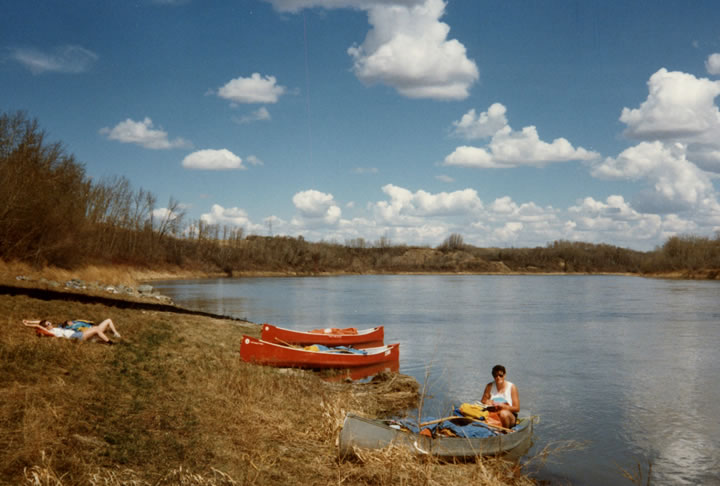
Explorations Day#21: 54 km of paddling, got sail up, but the wind had shifted from a tailwind into a headwind in the afternoon, I will try to ensure the sail and its riggings is handier than in the past (May19/89).
Explorations Day#22: 10 km of paddling into Prince Albert, where an Allen, an Army Buddy from the North Saskatchewan Regiment pick us and our canoes up. We then shopped, did laundry, showered and ate well, plus consumed a few beers (May20/89).
Explorations Day#23: 20+ km as Allen and Sheri gave us a great send-off as we left PA at noon. We did some very fast sailing out of town, but cracked the bottom of the mast. Rigging worked fine with all three boats lashed together (May21/89).
Explorations Day#24: 68 km of excellent paddling today with lots of current and good tailwind in morning, saw pelicans, elk, deer and beaver, passed the Saskatchewan River Folks and off the river at 19:30 (May22/89). Note: Longest daily distance of the trip, it’s funny in retrospect that my logbook contained no mention of the long distance we paddled that day, certainly much further than our proposed 60 km per day on River and 40 km on Lake or Shield.
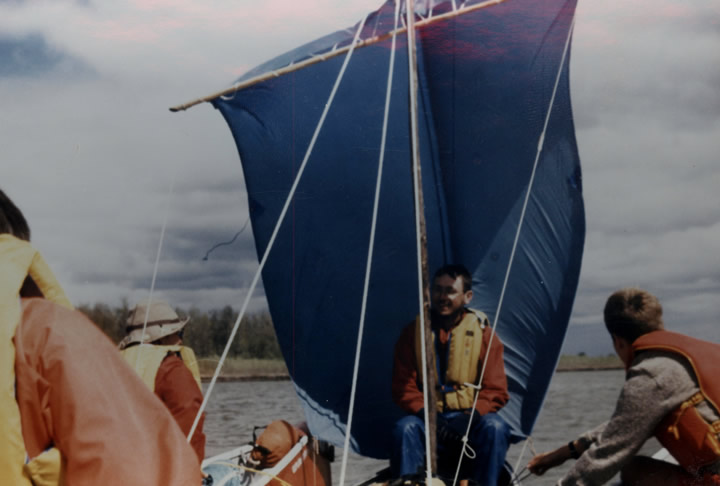
Explorations Day#25: 45 km of paddling in a wider, slower channel with a headwind and high banks with no campsites. We entered Codette Lake and camped at 19:15 (May23/89).
Explorations Day#26: 7 km of paddling in heavy rain and high winds with no current at all. After an hour and a half of horrible paddling, we camped and spent the rest of the day in our tents (May24/89).
Explorations Day#27: 18 km of paddling after getting up late, 10 km on Codette Lake, portage was vehicle courtesy of Saskatchewan Power and 8 km on the river beyond the dam to Nipawin Regional Park (May25/89).
Explorations Day#28: 45 km of sailing on Tobin Lake with 3 canoes lashed together, shore has massive amounts of driftwood, swells up to 1m on points but the wind was in our favour (May26/89).
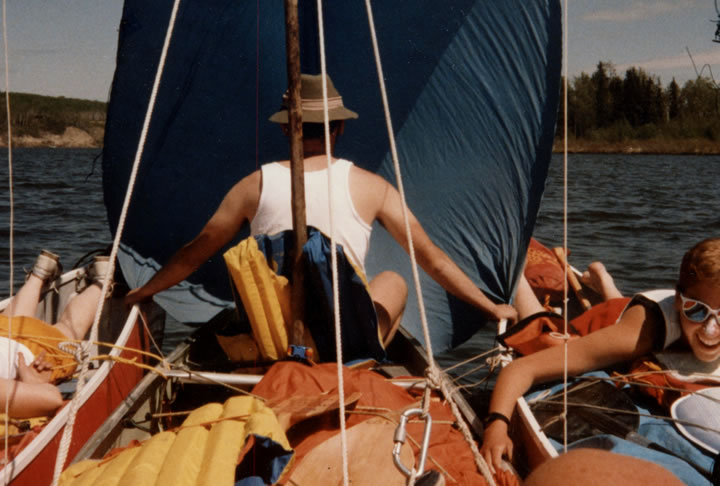
Explorations Day#29: 25 km of paddling to the dam by 15:30, then portaged with a bit of help and camped at Squaw Rapids Campground (May27/89).
Explorations Day#30: 50 km of paddling in good current, we saw large numbers of pelicans, beaver were plentiful, passed the junction of the Torch River and camped at 19:10 (May28/89).
Explorations Day#31: 58 km of complex paddling and tough navigation, made harder as we had no map for this section of river, managed to get through the myriad of channels west of Cumberland Lake and arrive at a boat launch south of Cumberland House (May29/89).
Explorations Day#32: Bypassed Class 3 Rapids in Cumberland House by lining on river left, 42 km of good current and paddling, found few camp spots, finally camping on a cutline 5 km short of the Saskatchewan border (May30/89).

Explorations Day#33: 60 km of good paddling, at Manitoba border by 9:30, good current, but few camp spots and few signs of civilization, finally found a campsite at 19:00 in beaver cut area (May31/89).
Explorations Day#34: 22 km paddle into the Pas, Manitoba, picked up food box and had coffee and cookies at Philip Lia's house (Jun1/89).
Explorations Day#35: 0 km as we had an off day for laundry and shopping, wandered about the town and enjoyed the riverfront Campground (Jun2/89).
Explorations Day#36: 38 km of paddling after a slow start out of town, the current was slower today, but the wind was in our favour for part of the day, camped at 19:30 beside a pump house and a nice pile of bear scat (Jun3/89).

Explorations Day#38: 40 km of varied canoeing, including very low weak river channel, marsh and the first rocks of the Canadian Shield, stopped for supper at 18:00, then canoed until 22:20 (Jun5/89).
Explorations Day#39: 0 km of paddling as we awoke to the sight of 3-5 foot white caps on the lake caused by high winds, waited all day for a break; reading and sleeping (Jun6/89).
Explorations Day#40: 0 km again today as we were stranded by whitecaps, large standing waves and a very shallow lake, walked to possible portage, but it was a swamp (Jun7/89).
Explorations Day#41: 43 km of paddling today in great scenery on Cedar Lake, camping would have been better in low water and camped 1.5 south of Easterville (Jun8/89).

Explorations Day#42: 30 km of great paddling on Cedar Lake in morning, had to stop early because of wind, had supper early again and paddled late until we hit high winds again at Calico Island (Jun9/89).
Explorations Day#43: Got up at 4:30 to high winds and did 0 km, Stranded on Island on Cedar Lake, spent most of the day writing and exploring the island (Jun10/89).
Explorations Day#44: 20 km, got up at 4:20 and travelled to the dam retaining wall, hitched a ride around the dam with two fishermen and then back onto the River until we got to Lake Winnipeg (Jun11/89).
Explorations Day#45: 0 km as rain and high winds stopped any chance of progress on Lake Winnipeg after (Jun12/89).
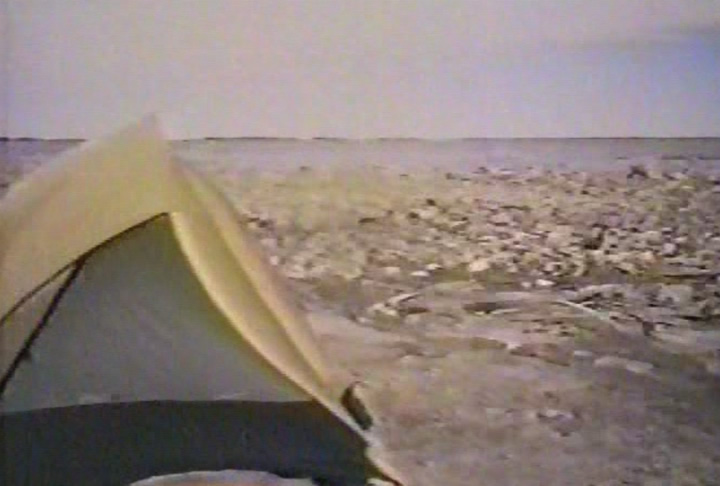
Explorations Day#46: 0 km as overcast weather and high winds again stranded us, spent the day deciding what we need to do after losing 5-days dues to wind on shallow lakes (Jun13/89). Note: For me, this was one of the hardest decisions we need to make, it took time and compromises, but it also ensured our successful conclusion of the Expedition.
Explorations Day#47: 0 km as we arranged a car and trailer to take us around to Hecla and drop us off on the western shore, the car was crowded, but better than a long portage (Jun14/89).
Paddle and Portage — the Canadian Shield
“The Joy of Travel is not Merely so much in getting where one wants to go as the Unsought Surprises that occur on the Journey” — Alan Watts21
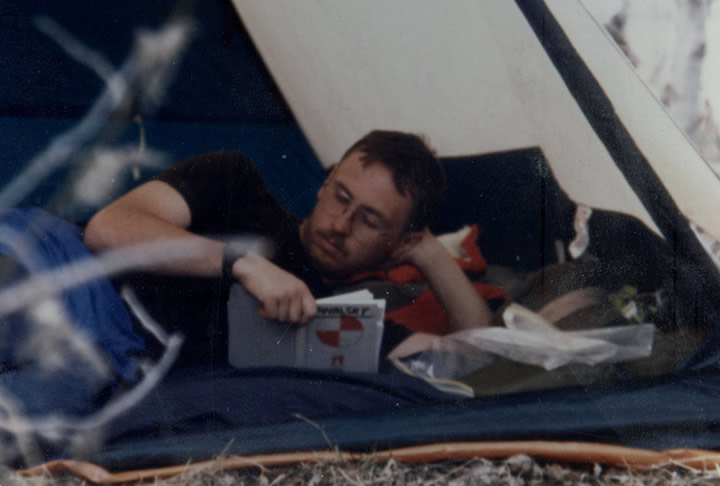
Explorations Day#48: 38 km of good paddling as we crossed Lake Winnipeg and made it down a bit of the eastern shore, big waves forced us off the lake by 16:00 (Jun15/89).
Explorations Day#49: 12 km of paddling from 8:30 until 12:30, when wind and waves forced us to shore, spent the day swimming and building sandcastles, lots of bugs and hot weather (Jun16/89).
Explorations Day#50: 15 km of paddling from 15:30 until 16:55, saw a black bear walking on the beach northward and met a solo paddler, rain and wind forced us off the lake (Jun17/89).
Explorations Day#51: 22 km of paddling, forced off lake 3 times and needed to paddle to 22:30, due to high winds and a thunderstorm, saw a black bear, suffered the attacks of tons of mosquitos and black flies (Jun18/89).
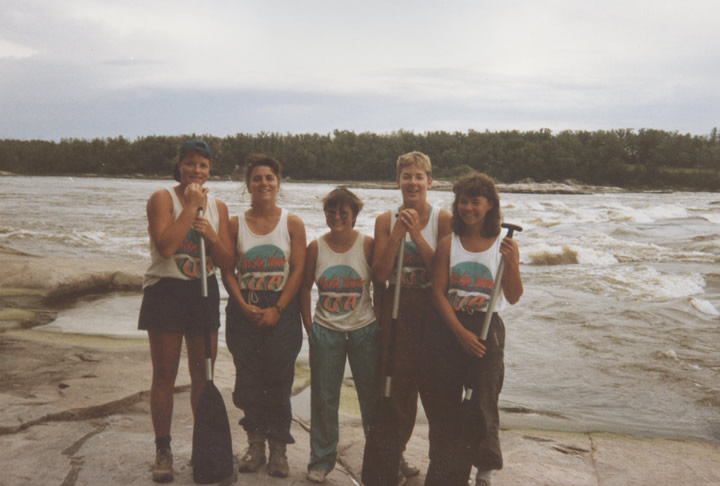
Explorations Day#52: 32 km as we canoed into the Winnipeg River and made it to the campsite in Pine Falls, current not bad and one short portage required (Jun19/89).
Explorations Day#53: 0 km as we stopped over in Pine Falls, picked more food boxes, a missing map for the upcoming river and sent pack excess spring gear (Jun20/89).
Explorations Day#54: 24 km on Winnipeg River including a portage around a dam and lining around Silver Falls, a rock face made the lining complex and we took our canoes one at a time as a team effort (Jun21/89).
Explorations Day#55: 30 km to McArthur Falls Dam, portaged on the right side using a boat launch paddled to Lac de Bonnet, stopped for Milk Shakes and pushed on for the last 5km upstream (Jun22/89).
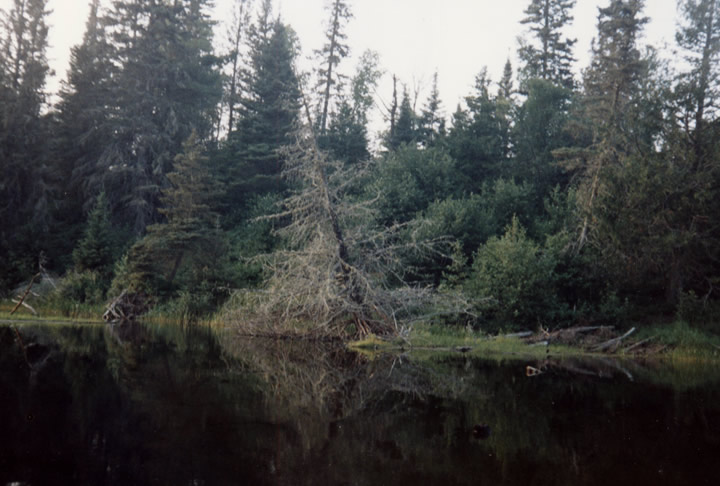
Explorations Day#56: 36 km of upstream paddling & 1km portage plus two short sections of lining, making it to Whiteshell Provincial Park by evening (Jun23/89).
Explorations Day#57: 25 km of upstream paddling & 3 portages plus 3 sections of lining, we had poor weather and rain for most of the day ending at Point de Bois (Jun24/89).
Explorations Day#58: 33 km of paddling plus 2 sections of lining to Lamprey Rapids, finally camping at LaVasseur Island at 18:45, saw a large Common Snapping Turtle while lining and loons are getting more plentiful (Jun25/89).
Explorations Day#59: 44 km of paddling & 1 portage plus 2 sections of lining, crossing into Ontario around 11:00 and got soaked during a rain delay (Jun26/89).
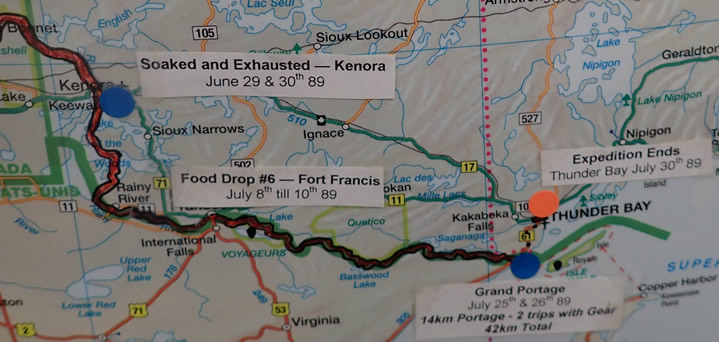
Explorations Day#60: 29 km of paddling & 1 portage plus 1 sections of lining where we DUMPED a canoe, wasted an hour chasing gear down the river and drying contents of the canoe, stopped for beers at the 4 Seasons Hotel, which was a culture shock and canoed until 22:00 (Jun27/89).
Explorations Day#61: 27 km of upstream paddling with a tougher current & 1 portage plus 3 sections of lining taking until 20:30, through constant drizzle in the evening (Jun28/89).
Explorations Day#62: 8 km of paddling & 1 mechanical boat lift, had supper while it poured rain in Kenora and watched the lightning, soaked and exhausted we gave up and booked a room at “Inn on the Lake” in which we stuffed in all 6 of us (Jun29/89).
Explorations Day#63: 36 km of paddling, after buying new maps, fuel and food, camped at Kennedy Island, just short of the Tranquil Channel, met our first canoeist on the trip, summer really had arrived (Jun30/89).

Explorations Day#64: 45 km of paddling across Lake of the Woods, paddled until 19:00 and Celebrating Dominion Day in style with a lit sparkler in the evening! (Jul1/89).
Explorations Day#65: 39 km of paddling in the Lake of the Woods, but were windbound and stopped by a storm with heavy rain and lightning (Jul2/89).
Explorations Day#66: 2 km of paddling to a point where we were winded in, finally we pushed our canoes through a small isthmus and paddled to shore and camped (Jul3/89).
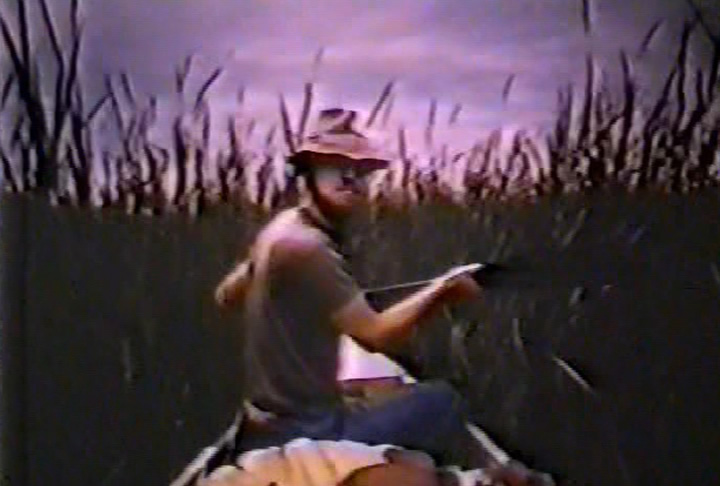
Explorations Day#67: Paddle at least 10 km, most before lunch and the afternoon included another push through a shallow swamp and a sand bar and camped at the mouth of the Rainy River (Jul4/89).
Explorations Day#68: 20 km of upstream paddling on the Rainy River, straddling the US/Canadian Border, at the Town of Rainy River at 16:00, shopped for food and paddled until 19:15, the storm that night bent some tent pegs (Jul5/89).
Explorations Day#69: 39 km of upstream paddling on the Rainy River, including a nice tailwind in the afternoon and camped at 20:00 (Jul6/89).
Explorations Day#70: 33 km of upstream paddling on the Rainy River & 1 Small Portage plus 1 Sections of Lining, strong current and high water, but no wind (Jul7/89).
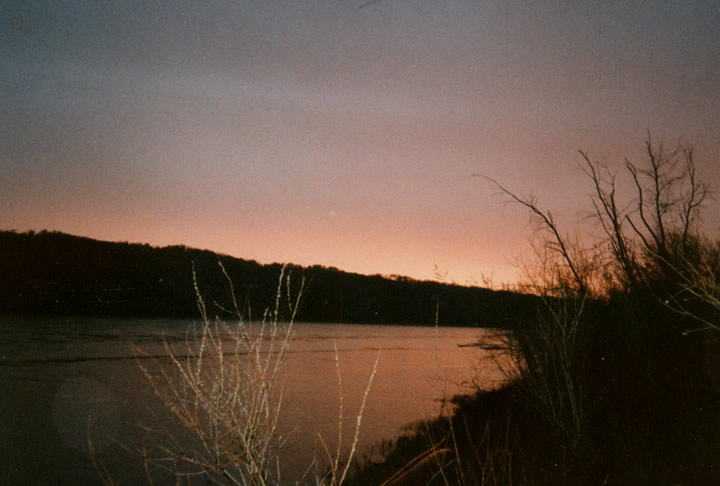
Explorations Day#71: 40 km of upstream paddling on the Rainy River, arrived at Fort Frances at 19:30 and camped in a back yard; showering and having a salad (Jul8/89).
Explorations Day#72: 0 km of paddling, portaged through the town via 2 vehicles, staying at “La Place Rendez-Vous,” did laundry, pick up our final food package and maps (Jul9/89).
Explorations Day#73: Cleared US Customs by walking across the bridge to International Falls, Minnesota and showing a Drivers Licence, we then packed our boats for the final leg and did 13 km of paddling from 16:30 until 19:30 (Jul10/89).
Explorations Day#74: 7 km of paddling only from 10:00 until 12:00 due to high winds at a point, ate lunch and slept all day, at 19:00 gave up and camped (Jul11/89).
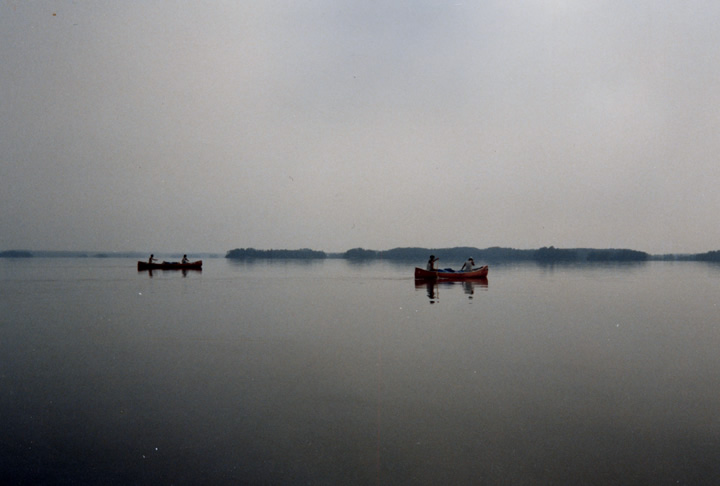
Explorations Day#75: 49 km of paddling by getting up early and paddling on a crystal clear lake, with some fog and rain, but it did not slow us down, late Lunch and made it to America Channel by 19:20, the best day in the shield country and we saw 3 turkey vultures (Jul12/89).
Explorations Day#76: 39 km of paddling & 1 mechanical portage at Kettle Falls, cleared through Government Island Customs House and camped at a nearby island, very beautiful narrows (Jul13/89).
Explorations Day#77: 38 km of paddling & 2 mechanical portage; Loon Falls and a shorter mechanical portages, saw a baby woodchuck and got a beer from the operator of the Loon Falls Portage (Jul14/89).
Explorations Day#78: 26 km of paddling, getting to Campbell's Cabins and getting the seat of the Springbok Canoe fixed by Bob Hamberg and then on to Lac La Croix Ranger Station, took a quick side trip to see Pictographs in unloaded canoes and stayed up with Joe Meany & Keith Burand, drinking American beer and swapping stories until midnight (Jul15/89).

Explorations Day#79: 35 km of paddling & 2 portages, got on the river by 08:00 and met up with Keith Burand as he began his scouting do to the loop in his new Kayak, had lunch with him at the Curtain Falls Portage (Jul16/89).
Explorations Day#80: 28 km of paddling & 3 portages, by paddling until 19:00 when we set-up camp at United States Point, sadly Jacqueline and I portaged an extra 1800m+ due to missing a turn off (Jul17/89).
Explorations Day#81: 24 km of paddling & 2 portages, we did make much better time on the portages today, camping early and cooking Bannock (Jul18/89).
Explorations Day#81: 24 km of paddling & 2 portages, we did make much better time on the portages today, camping early and cooking Bannock (Jul18/89).

Explorations Day#82: 34 km of paddling & 2 portages including a bit of swamp and camped on US Side, .5 km from Saganaga Lake (Jul19/89).
Explorations Day#83: 35 km of paddling across Saganaga Lake, then Pushed through 6 Portages & did 1 Portage and ended around 17:00 (Jul20/89).
Explorations Day#84: 31 km of paddling, pushed through 2 portages & did 4 portages, reached the Height of Land today and ate the last of my Liquorice Allsorts in celebration. Felt sick, worn out and could not eat supper. (Jul21/89).
Explorations Day#85: 17 km of paddling & 4 portages including the “Long Portage,” I was feeling slightly better today in spite of the cruelling portages, saw a cow moose and a small woodchuck (Jul22/89).
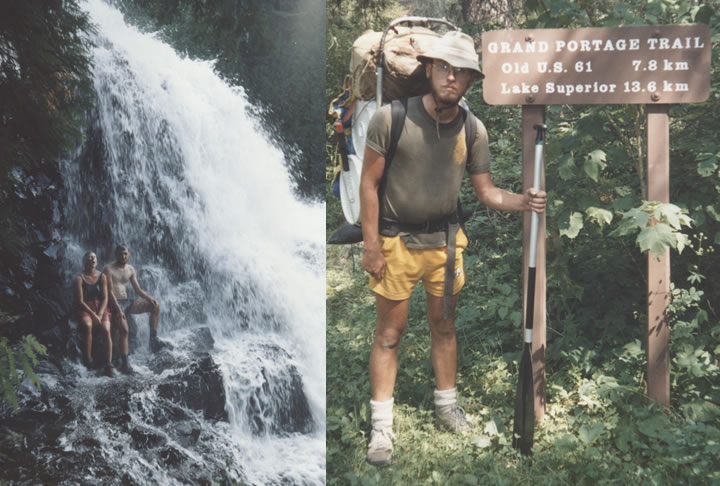
Explorations Day#88: 0 km of paddling & first half of Grand Portage, 14.9 km x3, roughly 22 km+ of Portaging to setup camp along the Old Highway (Jul25/89).
Explorations Day#89: 0 km of paddling & second half of Grand Portage, 14.9 km x3, roughly 23 km+ of portaging to our final victory of all of us putting our hands into the water of Lake Superior together (Jul26/89).
Explorations Day#90: 0 km as we got picked up by my Uncle Mike and travelled to Thunder Bay by vehicle, I finally realized we actually made it (Jul27/89). Note: The three days spent at my Grandmother's house was a fantastic and great way to decompress after the trip. It still amazes me to this day that she could feed the six of us effortlessly, just like we were a harvest crew coming in for supper on the farm in Manitoba.

Explorations Day#91: 4 km of paddling as we travelled up the Kaministiquia River to Old Fort William for an arrival ceremony and tour of the fort (Jul28/89).
Explorations Day#92: 0 km of paddling as we relaxed and ate as much as possible at my Grandmas House, amazing she could feed 6 of us without breaking a sweat (Jul29/89).
Explorations Day#93: Boarded a VIA Train for the 2000 km homeward journey overnight back to Edmonton, Explorations was truly a once in a lifetime experience (Jul30/89).
Explorations Day#94: On Train and our arrival in Edmonton, such a great greeting and nice to be home after 3 months on the rivers and lakes of such a wonderful country, Canada (Jul31/89). Note: The trip took us 90-days and found us both changed individuals and close friends at the end. Explorations altered my idea of what a wilderness trip was, my philosophy on outdoor education and taught me practical long-term thinking about wilderness travel.
Article by Bruce Zawalsky (20th September 2019)
Chief Instructor of the Boreal Wilderness Institute
Additional Resources
Footnotes
- “The Life of a River Expedition 1789-1989,” was a canoe expedition conducted as part of the University of Alberta's, Department of Physical Education and Sports Studies Explorations Programme.
- Carmen Ditzler, Cheryl Hunt, Jaqueline Hutchinson and Naomi McIlwraith.
- Singing Wilderness, Sigurd F. Olson, Alfred A. Knopf, Inc., 1956.
- We used three tandem open canoes with no shore support except for six food and supply drops, which, except for Edmonton were sent ahead in April by mail. Our food drops were in Edmonton, North Battleford, Prince Albert, The Pas, Pine Falls and Fort Frances. Each drop consisted of two to three boxes containing dried food, maps, toilet paper and other needed monthly supplies.
- Explorations Programme was run by the University of Alberta's, Department of Physical Education and Sports Studies between 1980 and 1996. It had both successful and unsuccessful years as some groups jelled and embraced the concepts and others had less success.
- Sadly only 12 credits.
- In the late 1980's the military and those who served in it were not well thought of generally at the University. No thought was given by most students or faculty to differentiate the US Army of the Vietnam Era and the Canadian Army. Sadly, numerous times classmates or students from other departments referred to me as a “baby killer” or other insulting references to my part-time service to my country. Fortunately, it pushed me to try harder to succeed. On a few occasions, it did get under my skin, getting me into the bad habit of throwing caustics insults back, instead of turning the other cheek.
- This quote often attributed to Mark Twain and found in numerous online sites. Virgin Galactic website (virgingalactic.com) used this quote in 2011 when describing suborbital space flights. The quotation has been well research as to not be a Mark Twain quote, see Quote Investigator for more details.
- Our expedition was essentially self-funded, the University of Alberta did lend us a water filter and a few items of equipment. When it finally became apparent that we were going, they then coughed up the money for our two sets of Topographical maps.
- Most interesting is that our requests to the Government of Alberta were rejected and instead a much larger sum was given to Lakehead University, for a similar but completely shore supported expedition. That “expedition” raised enough money to pay its paddlers, allowed them time off, paddle essentially empty canoes and had their meals cooked for them. This is a sad reminder that it is not what you want to do or what you might accomplish, but how good you are at writing grant proposals that get you government money.
- GPS and SARSAT Beacons had not been invented yet, Satellite Phones had just been introduced and were incredibly expensive at the time. So we did it all with maps and a compass.
- My life with the Eskimo, Vilhjálmur Stefansson, Macmillan Company 1913.
- Exhaustion and Fulfillment: The Ascetic in a Canoe," Pierre Elliott Trudeau, 1944.
- Carmen Ditzler' poem is, in my opinion, the best poem I have ever heard that truly describes canoe tripping and portaging.
- Song of the Paddle, Bill Mason.
- Singing Wilderness, Sigurd F. Olson, Alfred A. Knopf, Inc., 1956.
- Quote from an email sent to me from one of my fellow participants after reading the first draft of this article.
- Today I often use the candle as an analogy for the human body. You come into a survival situation with a finite number of calories or fuel. It is hard to get more once you are stranded. Like a candle, you cannot burn forever or survive unless you get more fuel and even burning very little by keeping the candle protected from the elements, it will not last forever.
- A Sand County Almanac: And Sketches Here and There, Aldo Leopold, 1949.
- Patty Sherman, sadly I wrote this quote out and placed in my “Thought for the Day” book long before the internet and cannot find the source any longer.
- The Way of Zen, Alan Watts, 1957.

